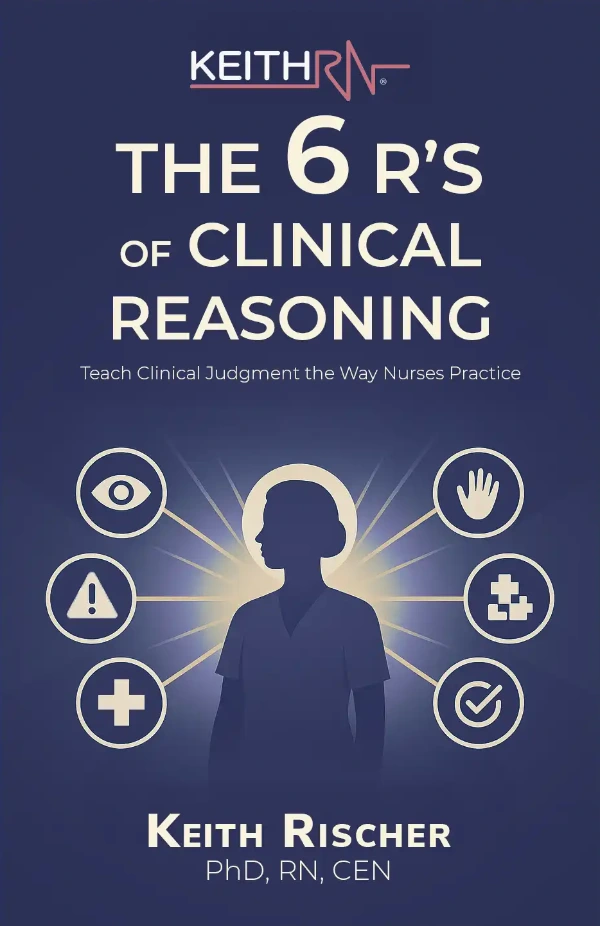
The title of this article is the mantra of Teresa Stephens, the keynote speaker at last month’s South Carolina Nursing Education Simulation Alliance Conference.
Dr. Stephen’s topic was using simulation to bridge the academic-practice gap. She touched on so many important points, and much of what she said resonated because it validated the purpose of KeithRN, which is to embrace educational best practices to prepare graduate nurses for practice.
Other than her mantra, which will stick with me forever, her question to the audience stimulated continued reflection:
“Why is thinking so elusive?”
Why do you think teaching thinking is so elusive in nursing education?
I think it is all too easy to become complacent as overloaded faculty members with the burden of educating students. We don’t question why we do things; we simply fall into TWWADI—The Way We’ve Always Done It.
A syllabus is handed to us pre-filled with learning objectives, readings, activities, etc. We say thank you and follow it, because it is already completed.
Why do we not take the time to question the learning outcomes, activities, policies, and clinical requirements? Is it because we’re too busy? Is it because we don’t care? I doubt it.
I think the most common reason is we don’t know how to question the assumptions or the culture of our departments. We accept the status quo.
Why is it that in higher education, we really don’t value thinking outside of the box? Group think is the unspoken assumption, and woe to any educator who fails to fall in line and dares to challenge the status quo!
We ask our students to think critically, help them develop their critical thinking skills, and make thinking the most important skill they must develop to provide safe patient care. Yet, do we critically think as faculty? Do we question why we lecture hour after hour, limiting students to use an outdated NANDA taxonomy to establish a precisely worded three-part nursing diagnostic statement for a 20-page care plan!?
If not, we should be!
We are required to follow evidence-based care as practicing nurses in the clinical setting, but are we following evidence based strategies to evaluate clinical performance? Do we incorporate evidence-based teaching strategies by consistently using active learning in the classroom?
If not, why not?
Is the classroom less important than time spent in the clinical setting? The classroom prepares students for clinical. In our nursing programs, we have more classroom time than clinical time. We must simulate the thinking of practice in our classrooms.
Case studies are more effective than other teaching strategies to promote student application of essential concepts (Vacek & Liesveld, 2020). Additional strengths and student benefits of case-based learning include:
- Improved clinical reasoning skills (Marcomini, et al., 2021)
- Increased student satisfaction and self-confidence in learning (Marcomini, et al., 2021)
- Improved patient assessment skills (Raurell-Torredà et al., 2015)
- Strengthened development of critical thinking, clinical reasoning, and problem-solving skills (Dehghanzadeh & Jafaraghaee, 2018; Hong & Yu, 2017; Li et al., 2019; Qi et al., 2018; Yoo & Park, 2014; Liu, 2023)
As educators, we must never forget that nursing is a practice-based profession. We must practice the thinking of practice. Using unfolding case-based simulations that capture the open-ended thinking (not multiple choice) of practice can transform any classroom into a replication of the clinical setting.
Patient-centered holistic care must be more than a QSEN competency in our curriculum, but the reason for everything we teach. Practicing caring for patients using realistic unfolding case studies using open-ended questions included in all KeithRN case studies such as, “What is your patient likely feeling right now?” and “How can you communicate that this patient matters to you?” make caring practical and central to the role of the professional nurse.
Closing Thoughts
Case-based scenarios/simulations are an evidence based strategy to better prepare students for practice. It is no coincidence that this is also the primary purpose of KeithRN. We remain committed to challenging the status quo in nursing education to develop the clinical judgment foundational for safe practice.
Hearing this needed emphasis from another educator was a delight, and seeing how well the audience received her message was even more of a delight.
As you begin a new school year, now is the time to be part of the change to challenge the status quo to bridge the academic-practice gap by “bringing the evidence” of using case-based, patient-centered learning into every setting, every day and see for yourself the difference it can make to transform the way nursing is taught to strengthen practice readiness!
Recommended Resources
Visit ThinkLikeaNurse.com to learn more about our evidence-based, patient-centered solutions for case-based and active learning.
References
Dehghanzadeh, S., & Jafaraghaee, F. (2018). Comparing the effects of traditional lecture and flipped classroom on nursing students’ critical thinking disposition: A quasi-experimental study. Nurse Education Today, 71, 151-156.
Hong, S. & Yu, P. (2017). Comparison of the effectiveness of two styles of case-based learning implemented in lectures for developing nursing students’ critical thinking ability: A randomized controlled trial. International Journal of Nursing Studies, 68, 16–24. https://doi.org/10.1016/j.ijnurstu.2016.12.008
Kulak, V., Newton, G. & Sharma, R. (2017). Does the use of case-based learning impact the retention of key concepts in undergraduate biochemistry? International Journal of Higher Education, 6(2), 110-120.
Li, S., Ye, X. & Chen, W. (2019). Practice and effectiveness of “nursing case-based learning” course on nursing student’s critical thinking ability: A comparative study. Nurse Education in Practice, 36, 91-96.
Liu, W. (2023). Effect of unfolding case-based learning on clinical judgment among undergraduate nursing students. Nurse Educator, 10 doi:10.1097/NNE.0000000000001526
Qi, M., Yi, M., Huang, H. & Yang, Y. (2018). Application of case-based learning in instructing clinical skills on nursing undergraduates. Biomedical Research, 29(2), 300-303.
Raurell-Torreda, M., Olivet-Pujol, J., Romero-Collado, A., Malagon-Aguilera, M.C., Patino-Maso, J. & Baltaser-Bague, A. (2015). Case-based learning and simulation: Useful tools to enhance nurses education? Nonrandomized controlled trial. Journal of Nursing Scholarship, 47(1), 34-42.
Vacek, J. & Liesveld, J. (2020). Teaching concepts to nursing students using model case studies, the Venn Diagram, and questioning trategies. Nursing Education Perspectives, 41(6), 373–375. https://doi.org/10.1097/01.NEP.0000000000000514
Yoo, M.-S. & Park, J.-H. (2014). Effect of case-based learning on the development of graduate nurses’ problem-solving ability. Nurse Education Today, 34(1), 47–51. https://doi.org/10.1016/j.nedt.2013.02.014
Keith Rischer – PhD, RN, CEN
As a nurse with over 35 years of experience who remained in practice as an educator, I’ve witnessed the gap between how nursing is taught and how it is practiced, and I decided to do something about it! Read more…
The Ultimate Solution to Develop Clinical Judgment Skills
KeithRN’s Think Like a Nurse Membership
Access exclusive active learning resources for faculty and students, including KeithRN Case Studies, making it your go-to resource.





